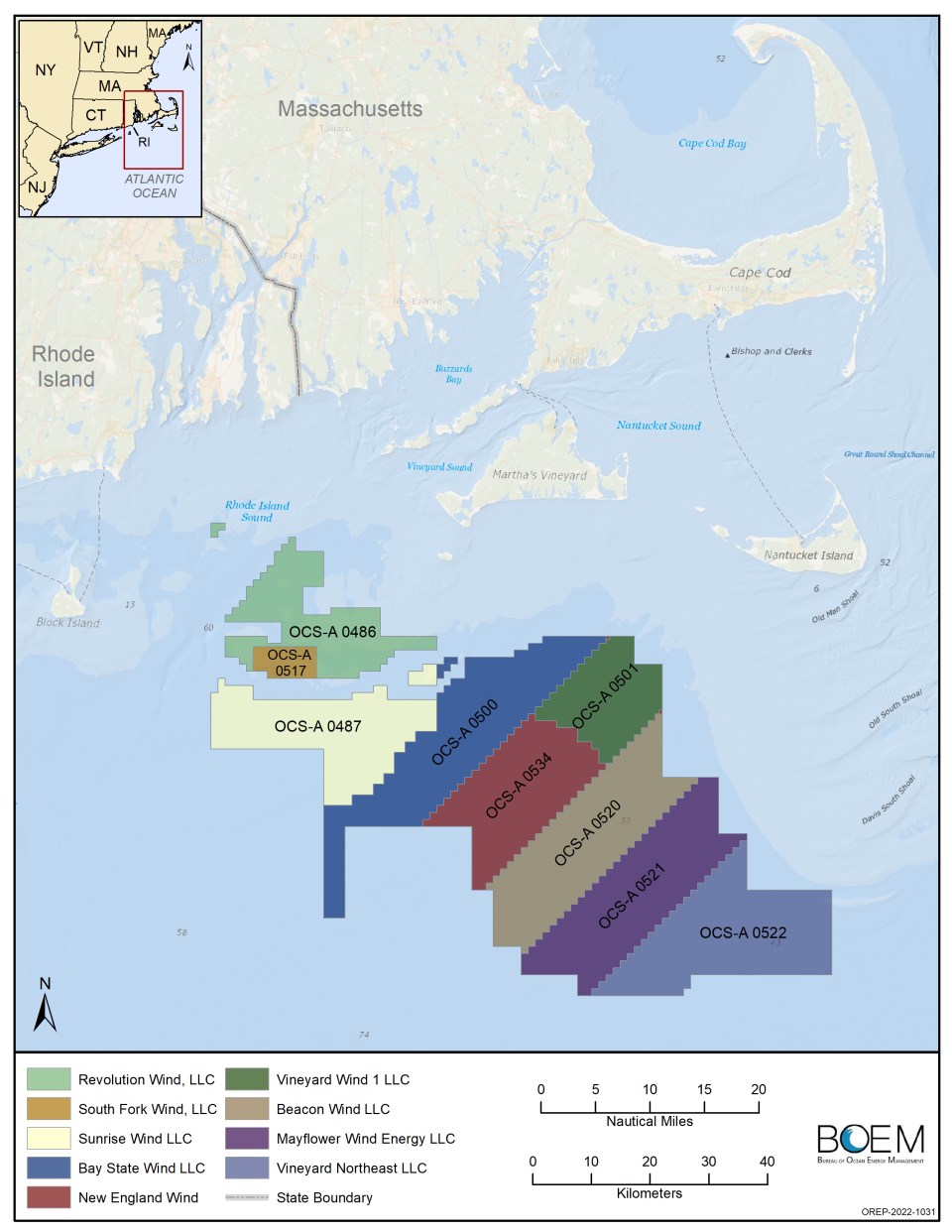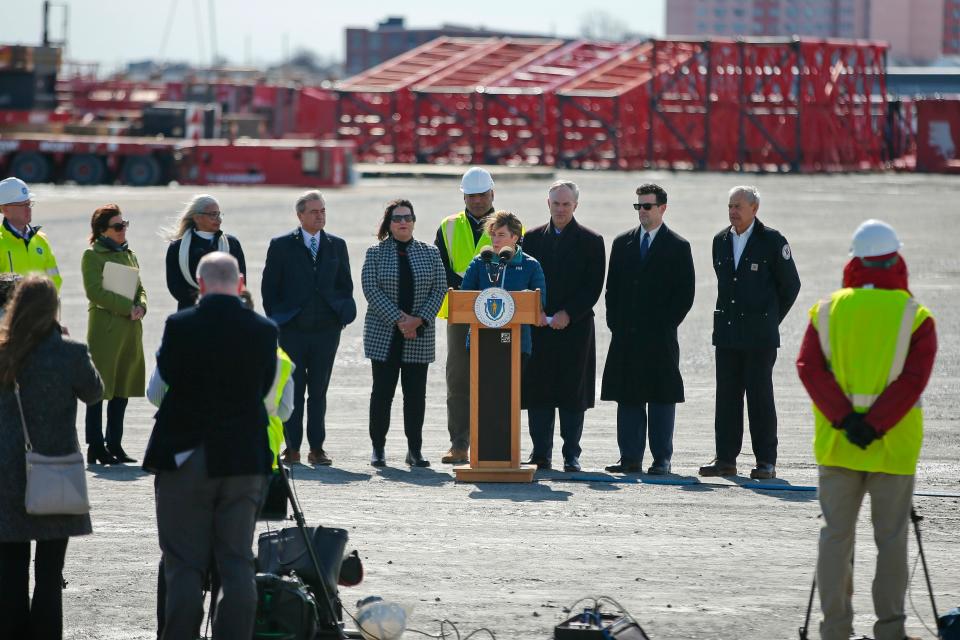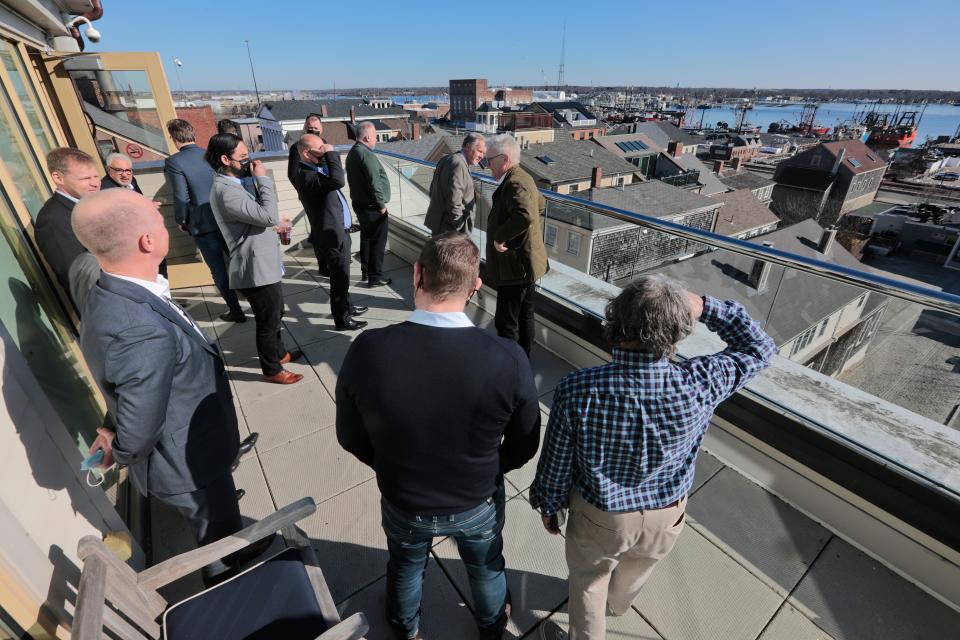Offshore wind in New Bedford: A guide to what you need to know
An already busy port of New Bedford will be even busier when the full effect of the offshore wind industry hits.
A direct impact on the New Bedford/Fairhaven Harbor is already being felt, and seen, most recently with the demolition of the former Eversource plant chimney to make way for the New Bedford Foss Marine Terminal on the New Bedford waterfront.
With Massachusetts preparing for a fourth round of funding for offshore wind projects, what comes next?
Offshore wind companies, electric companies and local leaders from Greater New Bedford have weighed in on changes that should be made to the process during this next round. Vineyard Wind was the winning bidder in the first round, Mayflower Wind Energy LLC won the second round, and Commonwealth Wind and Mayflower Wind LLC were the winning bids in the third round. Massachusetts is preparing for bid submissions for a fourth round of offshore wind contracts.
In March 2021, a bipartisan bill was signed into law that Massachusetts will procure an additional 2,400 megawatts of offshore wind energy by 2027, adding to the state’s previous solicitation that secured 1,600 megawatts of offshore wind capacity to be installed by 2027.
New Bedford Ocean Cluster: Marine industries can work together to help each other 'thrive'
At the national level, the Bureau of Ocean Energy Management manages the development of the Outer Continental Shelf, both its energy and mineral resources for environmental sustainability, economic development and national security.

It’s all in line with the Biden administration’s goal of installing 30 gigawatts of offshore wind power by 2030. (There are 1 billion watts in 1 gigawatt, and the average light bulb is 60 watts in comparison.)
Where does New Bedford fit into these plans?
New Bedford Marine Commerce Terminal and New Bedford Foss Marine Terminal key to offshore wind development
The New Bedford Marine Commerce Terminal, also known as the South Terminal, is designed to support the construction, assembly and deployment of offshore wind projects in addition to handling bulk, break-bulk, container shipping and large specialty marine cargo.
On March 16, Gov. Maura Healey held a press conference at the Massachusetts Clean Energy Center’s New Bedford Marine Commerce Terminal to announce her proposal to dedicate 1% of the state's budget to help make Massachusetts a "global leader in transitioning to a clean energy economy." At that event, she unveiled a proposal to triple the Massachusetts Clean Energy Center’s budget to further that effort, including in the pursuit of wind energy.

Clean energy initiative:Gov. Healey wants to dedicate funds to make state 'global leader' in clean energy economy
The Marine Commerce Terminal will consist of a 1,200-linear-foot bulkhead with deep water access and about 20 acres of surface space.
![The Marine Commerce Terminal can be seen below as workmen install an antenna overlooking New Bedford Harbor and the hurricane barrier in the background. [ PETER PEREIRA/STANDARD-TIMES FILE/SCMG ]](https://s.yimg.com/ny/api/res/1.2/HS36IXsdHoggbzQIEAhU0A--/YXBwaWQ9aGlnaGxhbmRlcjt3PTk2MDtoPTY0MQ--/https://media.zenfs.com/en/the-standard-times/0c5a664aa528fc753a51508a28e56278)
Demolition of the former Eversource Energy/Sprague Oil site that started in late July 2022 continued in January to make way for the New Bedford Foss Marine Terminal. Seattle-based Foss Maritime partnered with local investors from Cannon Street Holdings to develop the site.
Andrew Saunders, president of the New Bedford Foss Marine Terminal, oversees demolition, and construction, of the site, and will oversee operation and maintenance activity once the new terminal is operational.
The terminal will provide storage and laydown yards for equipment and materials, berth facilities for tug and barge operations and host crew transfer vessel and service operation vessel support services. There will also be office space and a marine coordination center for technicians.
Vineyard Wind, Commonwealth Wind and SouthCoast Wind Energy, formerly Mayflower Wind, are expected to utilize the services the terminal projects have to offer in terms of infrastructure.
What is Vineyard Wind?
A major player in offshore wind development with an office in New Bedford, Vineyard Wind, LLC is building what it calls “the nation’s first utility-scale offshore wind energy wind project” located about 15 miles off the coast of Massachusetts.
The 800-megawatt project co-owned by Avangrid Renewables, LLC, and Copenhagen Infrastructure Partners is expected to power more than 400,000 homes and businesses across the state while reducing carbon emissions by over 1.6 million tons per year.
Charles River Analytics, a Cambridge-based research company, and Vineyard Wind entered into an agreement in November aimed at protecting marine mammals using cutting-edge technology during the construction of its Vineyard Wind 1 project.
Vineyard Wind recently released a report that shows the company exceeded its job creation and economic output projections during the development and early construction phase. The report found that Vineyard Wind’s reported numbers double the initial projections in both jobs created and economic output, a fact attributed partly to a longer-than-expected development period and changes to the overall project parameters.
What is Commonwealth Wind?
Commonwealth Wind is owned and operated by Avangrid Renewables. However, plans for its 1,232-megawatt wind project intended to provide electricity to 700,000 homes in Massachusetts from the southwest portion of the company’s offshore lease area are at a standstill.
While awarded this project, Avangrid says it is no longer viable and has asked state regulators for dismissal of the power purchase agreements it reached with utility companies last year, with plans to try again during the next round of bidding, a process that has begun.
Avangrid also owns the 804-megawatt Park City Wind project which is the first phase of a larger project called New England Wind, but energy from this project in the northeast portion of the company’s offshore lease area will go to Connecticut.
What is SouthCoast Wind Energy?
It used to be Mayflower Wind, but as of Feb. 1, SouthCoast Wind Energy LLC, a joint venture of Shell New Energies US LLC and Ocean Winds North America, is its new name.
SouthCoast Wind’s full offshore wind lease area has a capacity of 2,400 megawatts – enough electricity to power more than 1 million homes and businesses. The first 1,200 megawatts will connect to the electric grid at Brayton Point in Somerset.
The Interior Department’s Bureau of Ocean Energy Management recently announced the completion of a draft environmental impact statement, further advancing the project. According to its website, BOEM will use the findings of the final environmental impact statement when deciding whether to approve the SouthCoast Wind project, or any other project.
New terminal in development on Pope’s Island
Recently, Vineyard Wind entered a partnership with New Bedford-based Shoreline Offshore, owned by the Quinn family, and SEA.O.G. Offshore to build a terminal on Pope's Island in New Bedford Harbor.
The terminal will feature a new berthing and fueling area for the crew transfer vessels that will service the Vineyard Wind 1 project and help meet the needs of other future developers.
Its two floating barges will be located on the northern side of Pope's Island, which is fully protected by the New Bedford hurricane barrier, and help developers work during both the construction and operations and maintenance phases of the different projects.
What is the New Bedford Ocean Cluster?
With establishing New Bedford as the leading ocean economy on the East Coast its goal, the New Bedford Ocean Cluster focuses on four industries — aquaculture, commercial fishing and processing, innovation and technology and offshore renewable energy. The New Bedford Ocean Cluster is a nonprofit organization created to serve the maritime business community in Greater New Bedford.
Led by Executor Director Jennifer Downing and a 10-member Board of Directors headed by President John Bullard, the NBOC has been focused on offshore wind while keeping in mind the challenges facing the fishing industry as a result.
Downing has said it will take careful planning and a lot of communication and planning, and in the meantime, looking to grow, the NBOC is in the process of hiring a business development manager to support its objectives, including attracting long-term investment.
Trade delegations from Europe visit New Bedford
Last year, the City of New Bedford, New Bedford Ocean Cluster, New Bedford Port Authority and New Bedford Economic Development Council hosted trade delegations from Denmark, the United Kingdom and Belgium to explore opportunities for partnership and investment in the offshore wind market.
The Belgian delegation’s visit, for example, was part of a Belgian Economic Mission to the U.S. organized by Flanders Investment & Trade and the Belgian Embassy to explore opportunities for partnership and investment in New Bedford’s offshore wind market.

Workforce training and certifications being offered by Bristol Community College and the National Offshore Wind Institute
Bristol Community College has been working to prepare the local workforce for jobs in the wind industry with construction of its training and certification facility, the National Offshore Wind Institute. Alan Lowdon, director of strategic development for NOWI, has been teaching an offshore wind offshore wind introductory class.
Jennifer Menard leads the way as NOWI’s vice president of economic and business development at 198 Herman Melville Boulevard. It's Wind Works campaign aims to facilitate the entry of community members in the Greater New Bedford area into the offshore wind industry.
A partnership with Maersk Training headquartered in Denmark offers Bristol Community College the experience of working with the developer of the first training center in the world to be credited by the nonprofit Global Wind Organisation. Maersk is a Danish shipping company active in ocean and inland freight transportation and associated services such as supply chain management and port operation.
Seeking to benefit from innovation
In New Bedford, local leaders have proposed a Massachusetts Marine Energy Innovation Center to support efforts to promote innovation so that Massachusetts can effectively compete against other states.
In a letter to Gov. Maura Healey, they ask that state leaders support efforts to develop the center to capitalize on the demand for innovation by the offshore wind industry.
Harnessing the Wind:Change is in the air with the offshore wind industry ascending. Will Massachusetts be ready with the workforce needed?
Blowing away the competition:Competition fierce for offshore wind's a 'once in a generation opportunity'
Developing the local supply chain
In October, the Business Network for Offshore Wind and Vineyard Wind announced a new partnership to educate Massachusetts businesses about opportunities in offshore wind and build out and increase diversity in the local offshore wind supply chain.
One of their goals is to integrate small businesses as well as those owned by minorities, women, veterans, service-disabled veterans, those with a disability, and LGBT individuals into the local supply chain.
How have world events caused wind farm construction costs to increase?
What's troubling offshore wind companies that are still early in their permitting process is the sharp increase in prices owing to international market conditions and burgeoning worldwide interest in offshore wind development. Executives with New England Wind pointed at the war in Ukraine, record increases in interest rates, inflation, supply chain issues and high demand for wind farms in Europe and elsewhere as causes.
SouthCoast Wind is targeting the end of January 2024 to have its environmental review and permitting completed. The company is looking to start delivering power by 2028.
For this reason, Avangrid is planning to re-bid its projects while continuing with the permitting already underway. Commonwealth Wind will do this with the next Massachusetts offshore wind power procurement round in April, and the company is working with Connecticut officials either to renegotiate their existing contract or go to bid again.
Wind power: How offshore wind power works
Wind turbines work on a simple principle, the Office of Energy Efficiency and Renewable Energy notes: "Wind turns the propeller-like blades of a turbine around a rotor, which spins a generator, which creates electricity." Specifically, the kinetic (or moving) energy of wind is converted into electricity using the aerodynamic force from the blades.
"When wind flows across the blade, the air pressure on one side of the blade decreases. The difference in air pressure across the two sides of the blade creates both lift and drag," according to the agency. "The force of the lift is stronger than the drag and this causes the rotor to spin."
The rotor, in turn, creates rotation in a generator that converts the mechanical energy into electricity. The power is collected by an offshore substation before it is transmitted ashore through submarine cables, is run through on-shore substations and finally enters the power distribution grid.
In the case of offshore power, the electricity travels under the seabed at higher voltages than onshore because it is more efficient. Onshore substations put the power through a series of transformers to downgrade the voltage so it is compatible with the capacity of the distribution lines.
How will wind-generated energy impact your electricity bill?
With wind power in the mix, wholesale electricity rates won't be affected as much when the costs of fossil fuels rise.
According to the U.S. Energy Information Administration, natural gas was the largest source of energy for electricity production in the U.S. in 2021, accounting for about 38%, followed by coal at 22% and petroleum at less than 1%. Other sources are nuclear energy and renewable energy.
When fossil fuel prices go up, or supplies are short, electricity rates rise. With power from offshore wind flowing through the grid, there will be less volatility and generally lower rates overall.
Standard-Times staff writer Kathryn Gallerani can be reached at kgallerani@gannett.com. Follow her on Twitter: @kgallreporter. Support local journalism by purchasing a digital or print subscription to The Standard-Times today.
This article originally appeared on Standard-Times: MA offshore wind a priority for New Bedford's economic development

 Yahoo Autos
Yahoo Autos 